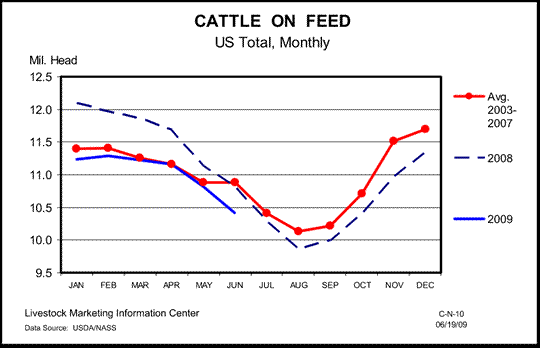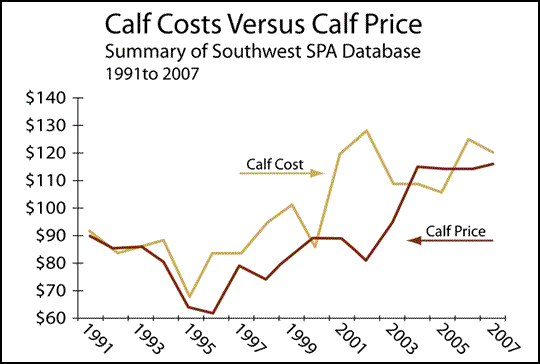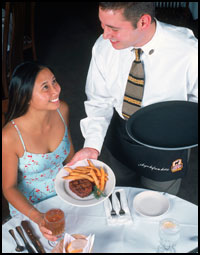MARKETING...
Cattle on Feed – 6/19/09

Cattle and calves on feed for harvest in the United States for feedlots with capacities of 1,000 or more head totaled 10.4 million head June 1, 2009. The inventory was 4% below June 1, 2008, figures.
Placements in feedlots during May totaled 1.64 million head, 14% below 2008. Net placements were 1.54 million head. This is the second-lowest placements level for the month of May since the series began in 1996.
Marketings of fed cattle during May totaled 1.95 million head, 9% below 2008 figures. This is the lowest fed-cattle marketings for the month of May since the series began in 1996.
Other disappearance totaled 101,000 head during May, 26% above 2008 figures.

Tim Petry
In the Cattle Markets
Fireworks displayed in feeder-cattle futures.
Usually, the 4th of July holiday is a quiet one in the feeder-cattle market, with many auction markets closed and reduced direct trade. In spite of the holiday atmosphere in the cash market, fireworks occurred early and often in the futures market. Read more.
Remain Viable in the Cow-Calf Business

Since 2008, the cattle market has made dramatic adjustments as calf and feeder-cattle prices decreased and the feedlot sector experienced significant losses. At the same time, other input costs have risen, taking cow costs to historic highs. Throughout this period, cattle numbers have continued to decline.
Since cow-calf producers have little control over factors outside the ranch, the best approach is to focus on ranch management decisions. Keep in mind that some cow-calf operations will make a profit with $80-per-hundredweight (cwt.), 500-pound (lb.) calves, while others can lose money with 500-lb. calves bringing $150 per cwt.
Each operation must assess its viability by determining its unit cost of production. Calculating unit cost of production will also make known the margins generated by the operation’s income and expense. (See the annual difference between calf price and calf costs per cwt. in the chart above.)
What is the difference between a high-margin producer and a low-margin producer? A high-margin producer considers all of the inputs, while maintaining a higher level of production. For an operation to be competitive and profitable in the long run, it will need to produce calves with high market value. This means using superior genetics and best management practices (BMPs) to create identifiable value. At the same time, controllable costs must be managed to create the greatest margin.
Most cow-calf operations were unprofitable in 2008, but how do you compare? It has become vitally important for each producer to make adjustments to attain improved margins. To do so, each operation must either increase revenues, decrease costs or both.
To determine how your operation is doing and how you can improve your margins, give the Noble Foundation a call.
© 1997-2009 by The Samuel Roberts Noble Foundation, Inc.
Economist Expects Robust
Improvement of Cattle Prices
The beef industry has suffered one of the most dramatic negative impacts from the general economy, but it could experience an equally dramatic recovery when the economy rebounds, said a Purdue University agricultural economist.
“As beef cow numbers continue to drop, beef exports continue to improve and the world economy begins to heal, the magnitude of price improvement may be robust by sometime in 2010,” Chris Hurt said. Read more.

Sara Snider
The Source
What's new with AngusSource®?
After nearly four years of operation as a USDA Process Verified Program (PVP), business is booming for AngusSource.
Although there isn't anything "new" to report at this time, there is plenty going on. June year-to-date figures show enrollments up by 11.2%, the feedyard umbrella program continues to grow, and customer feedback continues to be positive. Feedback forms submitted show that customer service, program tags and overall performance of the program are meeting producer expectations. Producers across the country also report that they are receiving additional dollars for their AngusSource calves selling from the ranch, at their local auction market or on the video auctions. Read more.
Quality in the Price Equation
 Feeders bid on cattle by penciling out the highest price they can pay and still maintain a shot at profit. Packers need a certain number of cattle harvested through their plants, bought at a particular price, to stay afloat.
Feeders bid on cattle by penciling out the highest price they can pay and still maintain a shot at profit. Packers need a certain number of cattle harvested through their plants, bought at a particular price, to stay afloat.
That cost/sales formula follows beef as it continues toward consumers.
Distributors have buying equations down to a science. They must be responsive to supply and demand because they want to make money, but their customers must thrive, too.
“On the front side we’re very strategic,” says Ron Becker, president of Stock Yards, a business unit of U.S. Foodservice Inc. The Phoenix, Ariz., distributor watches historical trends, anticipating beef sales so it can forward-contract with packers.
“We keep our salespeople on top of what the markets are doing,” he says. That lets them keep customers updated. “We’re constantly coaching on things, like in a tough economy it’s a bad time to lower your quality.” Read more.

Miranda Reiman
CAB Corner
Going once, going twice …
Sold. That word can be cause for celebration or the beginning of a personal pity party. It all depends on what dollar amount follows that auctioneer’s decree.
Studies have found and quantified just about everything that can make you more money at the sale barn or on the video auction: lot size, breed type, sex, preconditioning program and many more, including your reputation. Each variable affects the price your feeder calves bring.
You control the lion's share of those variables, although it may seem like you're at the mercy of the market. Even that basic price risk may be tamed with some price hedging and seasonal strategies, but the point is to make sure you're topping the day's trade instead of selling at the bottom. Read more.
USDA Market News
Click here for Livestock Cattle Reports, including Slaughter and Feeder and Replacement Cattle Reports.
Resources for Niche Markets
Click here to learn more about producing natural and organic beef
and/or grass-fed beef.





